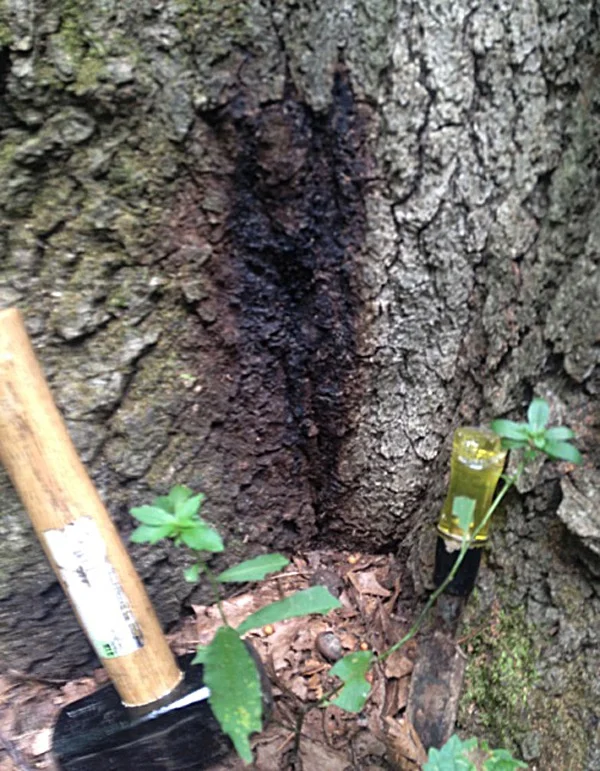Several weeks ago a client called the office about some Red Oaks that were dying, one by one. I arrived at his home in north Columbus and he quickly filled me in on the details: Two years ago one tree died, last year one other tree died (neighbor’s tree nearby) and this year two more trees had died.
After inspecting the site I found the mature Red Oak were within about a 50’ diameter area, and were all defoliated. One tree still had some dead leaves attached to limbs high in the canopy as well as some sprouts in the inner canopy with a few remaining green leaves. The site was a nice stand of native woods surrounding a ravine area that spans across the rear of multiple properties.
I inspected the base of the tree and found some weeping spots at the base of the trunk on two of the trees:
There were a couple of areas with vertical cracks oozing black seepage. These symptoms, coupled with the fact that the trees had died quickly, brought a couple of ideas to mind, but I wanted to sample the trees and send them to the lab for a proper diagnosis as all the things I was thinking of were very serious. The client had done some research on his own and suspected Oak Wilt. I had not heard of this in our area, although I was aware that this is a problem north of the Columbus area.
Samples were retrieved from the middle canopy, selecting two branches that had both dead and live leaves in hopes that a transitional section could be sampled. After several weeks, the C. Wayne Ellett Plant and Pest Diagnostic Clinic (The Ohio State University) was able to identify the fungus Ceratocystis fagacearum which causes Oak Wilt.
Please follow this link for the Ohio State University Extension Fact Sheet on Oak Wilt, where the information summarized below is drawn from.
The implications of this are serious. All oak varieties are susceptible, and Red Oak seem to be particularly vulnerable.
The disease can be spread both by root grafts (roots from neighboring trees growing together) and by sap feeding beetles and possibly oak bark beetles. Because it spreads in two ways, two approaches are needed to stop the spread of the disease.
The beetles that are vectors for the disease area attracted to fresh wounds on Oak trees, so pruning of Oaks during the growing season when the beetles are active is not recommended. A pruning wound will attract these beetles, and if they have been feeding on infected trees, the healthy trees will be subsequently infected.
To prevent infection from tree to tree, trenching between trees is recommended to sever any root grafts. This is not always feasible depending on soil type and tree location, and trees must be accessible with proper equipment.
A fungicidal trunk injection can be applied preventively to healthy trees in order to help protect them from infection. The treatment needs to be reapplied every one to three years in order to maintain its efficacy.
In Closing: I have an Oak tree. What does this mean for me?
- For maximum safety, do not allow your tree to be pruned during the growing season when beetles are active.
- If your tree is a vital part of your landscape, consider a trunk injection to increase the odds it will not be infected.
- If your trees are infected and need to be removed, make sure the Certified Arborist doing or directing the work knows how to dispose of the material to prevent spreading the fungus.


